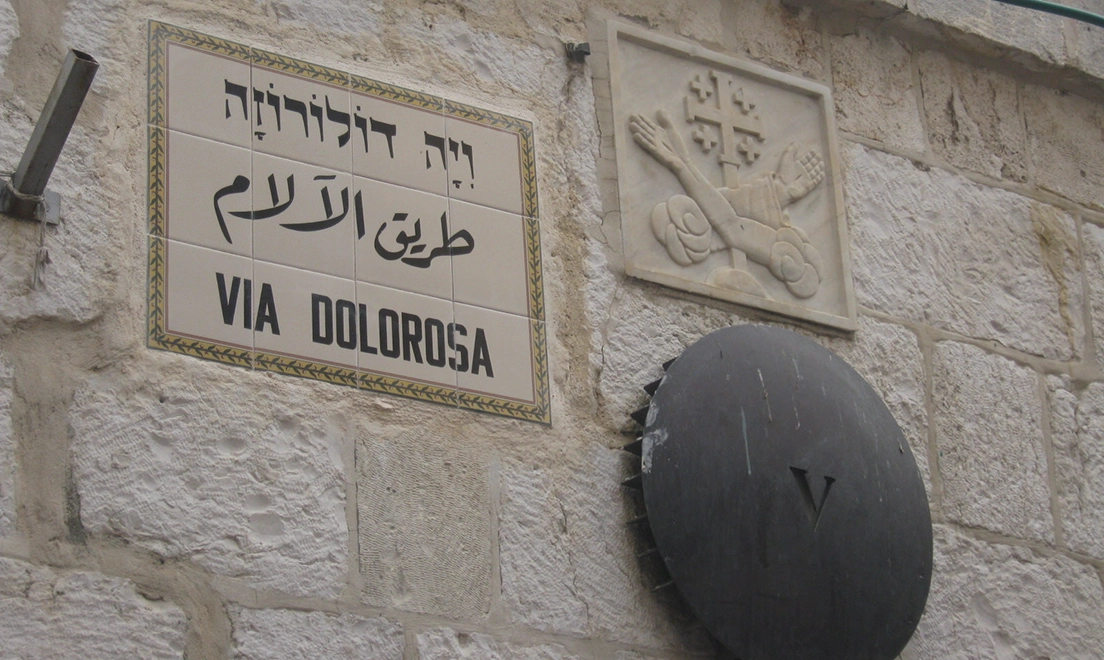
It is a weekly tradition in the Holy Land to walk the Via Dolorosa (Way of Sorrow, or the Way of the Cross) on Fridays at 3:00 p.m. The Franciscans lead this procession through the winding streets of the Old City of Jerusalem following in the footsteps of Christ and His suffering.
The procession marks the path Jesus walked under the weight of the Cross. It begins at the Fortress Antonia, where Pilate made his final judgment, and winds through the Old City to the Church of the Holy Sepulchre, where Jesus was placed in the tomb after His crucifixion. The Via Dolorosa procession is traced back to the early centuries of Christianity and is today marked by the Stations of the Cross.
The procession carries a very special devotion for pilgrims, particularly those who visit the Holy Land during Lent. They not only spiritually experience the places of Christ’s life, death and resurrection, they walk in the footsteps of Christ as His humble companions.
For pilgrims to the Holy Land, this walk is not just an experience to show solidarity with Christ’s passion but it is an essential exercise that helps them adore, love, and thank Christ for his suffering. On any given day, one can see numerous groups of pilgrims from all over the world carrying crosses of their own walking and praying at the various stations.
The literal Stations of the Cross may physically be in the Old City of Jerusalem but Popes throughout history have shown us the importance of this spiritual journey for all the faithful. In 1686 Pope Innocent XI permitted the Franciscans to erect displays of the Stations in all their churches. He also declared that all indulgences given for visiting the sacred sites in the Holy Land would apply to any Franciscan visiting a set of stations in a church.
Pope Benedict XIII extended that privilege to all the faithful in 1726. He also specifically urged every church in 1742 to enrich its sanctuary with stations. From simple paintings to life-sized replicas, Stations of the Cross abound throughout the Catholic world, and one needn’t travel far these days to follow the footsteps of Jesus.
We are all invited to walk along the road with Jesus, no matter the season. However, it is during Lent that this particular devotion is practiced more fervently. This Lent may we all make time to find ourselves at the Stations of the Cross – no matter what church we visit – to reflect and pray on the path through the Old City of Jerusalem.
The Stations of the Way
Station 1- Jesus is sentenced to death
Station 2 – Jesus is given the Cross
Station 3 – Jesus falls for the first time
Station 4 – Jesus meets His Mother
Station 5 – Simon the Cyrenian helps carry the Cross
Station 6 – Veronica wipes Jesus’ face
Station 7 – Jesus falls for the second time
Station 8 – Jesus talks to the women of Jerusalem
Station 9 – Jesus falls for the third time
Station 10 – Jesus is stripped of His garments
Station 11 – Jesus is nailed to the Cross
Station 12 – Jesus dies on the Cross
Station 13 – Jesus is taken down from the Cross
Station 14 – Jesus is laid in the tomb



